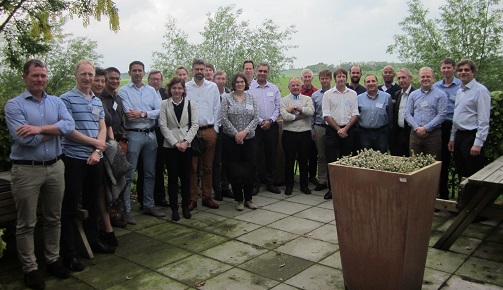International standard for CIDP registry and biobank
- Number 231
- Date 12 May 2017
Location: Naarden
Translations of the report hereunder:
Spanish
German
Italian
Dutch
French
Organisers:
Dr. Filip Eftimov (Amsterdam, The Netherlands), Prof. Dr. Yusuf Rajabally (Birmingham, United Kingdom), Dr. Luis Querol (Barcelona, Spain).
Description of the workshop:
The 231th ENMC workshop entitled “International Standards for CIDP Registry and Biobank” took place from the 12th to the 14th of May 2017 in Naarden, The Netherlands. A multidisciplinary group of 24 people from 13 countries (The Netherlands, United Kingdom, USA, France, Italy, Spain, Belgium, Denmark, Malaysia, Serbia, Germany, Curacao and Australia) attended the workshop. These included (young) researchers and clinical experts in inflammatory neuropathies and 1 patient representative from the patient organisation “Spierziekten Nederland” and GBS/CIDP Foundation International.
Background
Chronic Inflammatory Demyelinating Polyradiculoneuropathy (CIDP) is an immune-mediated neuropathy causing severe disability. CIDP is a remarkably heterogeneous disorder with various atypical clinical phenotypes. Furthermore, despite various sets of diagnostic criteria, not all patients with treatable CIDP are identified. Despite proven effective treatment, at present no clinical or biological variables are available to predict treatment response, disease activity and outcome. Further research is urgently needed to define the diagnostic clinical and electrophysiological boundaries of CIDP and its subtypes, and to define the role of biomarkers (e.g. nerve ultrasound, blood characteristics) in supporting the diagnosis, monitor disease activity and predict response to treatment and long-term outcome.
To address these research questions, it is required to conduct a prospective study with a large group of well-defined CIDP patients during a long follow-up period, collecting highly standardized clinical data, electrophysiological data and biomaterials.
In recent years, several national registries and biobanks have been developed to enable systematic data collection in CIDP. However, even in large countries, these registries will not be able to include sufficient patients to address the most important challenges described above. An international registry with large number of patients is needed to allow validated prognostic models to predict outcome in individual patients with CIDP.
Aim of this workshop:
To reach international consensus on the inclusion of CIDP patients, and the collection of clinical and diagnostic datasets and biomaterials.
Achievements:
Eight currently ongoing international CIDP registries were compared to assess infrastructure and collected clinical data, diagnostic data and biomaterials.
Consensus was reached on:
- Inclusion criterion: clinical suspicion of CIDP; Exclusion criterion: other diagnoses.
- Extended baseline characteristics needed to define clinical and diagnostic characterisation of patients but minimal core of clinical data is yet to be defined.
- Flexible follow-up visits with preferably at least a 2-year follow-up. Minimal outcomes during follow-up: a) grip strength, fatigue, disability (INCAT and RODS), quality of life (EuroQol) in all participants and b) impairment outcome measures based on individual patient characteristic at physicians discretion.
- A minimal protocol for nerve conduction study was suggested.
- Collection of biomaterials (serum, CSF, nerve biopsy) should be according to standardised protocols, with at least serum collection at baseline. Biomaterials are stored in participating centers or coordinating centers.
- Infrastructure: a central database (INCbase) will be developed to which data from existing database can be uploaded. A set of requirements for INCbase was defined. Current registries and databases continue to exist.
- All centers remain owner of data and can withdraw data from INCbase.
Proposed plans:
- Task force to A) combine current data of existing CIDP registries; B) harmonize the current registry protocols C) set up of a central database.
- The task force has proposed a timeline for the development and finalization of this registry with a plan to include first new CIDP patient into the registry by March 2018.
- Information on proposed consensus/registry protocol will be presented and discussed in the coming Peripheral Nerve Society meeting.

Participants:
Dr. S. Reddel (Sydney, Australia), Prof. dr. J. Vallat (Limoges, France), Prof. dr. J. Antoine (Saint-Etienne, France), Dr. J. Allen (Minnesota, USA), Dr. I. Basta (Belgrade, Serbia), Prof dr. A. Uncini (Chieti, Italy), Dr. K. Doppler (Wurzburg, Germany), Dr. R. Hadden (London, UK), Dr. T. Harbo (Aarhus, Denmark), Dr. H. Lehmann (Cologne, Germany), Prof. dr. P. Van den Bergh (Brussels, Belgium), Prof. dr. D. Cornblath (Baltimore, USA), Dr. S. Goedee (Utrecht, The Netherlands), Dr. M. Lunn (London, UK), Dr. I. Merkies (St. Elizabeth hospital, Curacao), Prof. dr. E. Nobile-Orazio (Milan, Italy), Prof. dr. B. Jacobs (Rotterdam, The Netherlands), Mrs. P. Blomkwist-Markens (GBS/CIDP Foundation International, patient representative), Drs. FL. Hiew (Kuala Lumpur, Malaysia), Drs. M. Adrichem (PhD-student Amsterdam, The Netherlands), Drs. C. Bunschoten (PhD-student Rotterdam, The Netherlands), Prof. dr. Y. Rajabally (Birmingham, UK), Dr. L. Querol (Barcelona, Spain) and Dr. F. Eftimov (Amsterdam, The Netherlands).
A full report of this ENMC workshop is published in Neuromuscular Disorders (pdf).
This workshop was co-sponsored by Grifols S.A. ![]()
